PANIC DURING THE SWIM
Ron Saetermoe
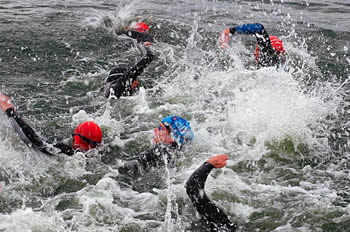
The bane of many a triathlete is the swim. They seem to enjoy the cycling and running training but pretty much hate everything about the swim.
With that hate comes fear. Fear of everything: getting kicked, losing goggles, drowning, sharks, etc. Coming from a swimming background I personally don’t get it but let me tell you a story, because I can relate.
The Ironman start is a mass-start, which means that you, along with 2000+ of your closest friends, all start at the same time. Stuff is just going to happen when you jamb that many people together – you just have to accept it.
Last year at Ironman Arizona I got into the freezing cold water (about 53 degrees) 20 minutes before the swim start. Big mistake! I’m not fond of cold water in the first place but to be treading water for 20 minutes in it was just stupid.
I became hypothermic and was shaking badly and had a hard time breathing. When the gun went off my legs, from the waist down, completely froze up with cramps. The pain was horrendous and the only thing worse was the fact that I also couldn’t breathe! Naturally, the next thing I did was vomit! Not a good start for me.
Okay, so what can you do? The first thing NOT to do is panic! Difficult when you’re completely cramped up and can’t breathe I know, but that’s where you start.
The next thing is to figure a course of action. In my case I thought maybe I could get to the shore to work the cramps out. The problem is there were so many other people between me and the shore that that was out of the question.
You do have options. Here are a couple of them:
1. Get to shore until the conditions change (i.e., you cramps, the waves, etc.). Generally, you won’t be DQ’d (disqualified) unless you make forward progress.
2. Get to a lifeguard. They can usually be found on a surfboard or kayak. You’re welcome to hold onto them as long as you don’t make forward progress.
3. Keep moving, albeit slowly. Try to keep making forward progress to the best of your ability. Your situation may improve just by moving forward.
4. Roll to your side or back. The triathlon swim does not dictate what stroke you have to swim. Backstroke or sidestroke are completely acceptable.
5. Move out of traffic as soon as possible. Your inclination may be to take the shortest path but that’s where the traffic is. Just like driving your car, get into the slow lane.
6. Quit. It’s not worth drowning over. We all have bad days. Write this race off and come back and kick ass next time.
Like most athletic endeavors, there simply isn’t any substitute for being prepared. Try to simulate race conditions as much as possible. Try to swim in the ocean before your ocean race. Get some friends together and simulate a mass-start. Practice backstroke and sidestroke. The more you’ve thought these situations through the better able you’ll be to deal with them.
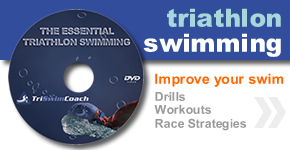 THE ESSENTIAL TRIATHLON SWIMMING DVD
THE ESSENTIAL TRIATHLON SWIMMING DVD
Discover the secrets to improving your swim technique, avoiding painful injuries, and shaving minutes off your best triathlon times to date! Are You Ready To Make A Change In Your Athletic Life?
ETIQUETTE
Ron Saetermoe
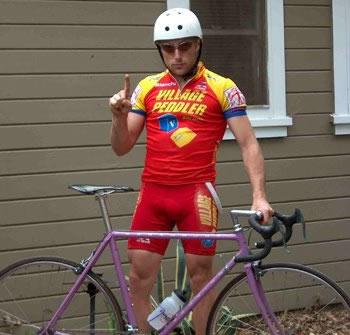 I don’t hear it talked about much but etiquette plays a big part in our sport. It hit me Saturday as I was riding on Santiago Canyon.
I don’t hear it talked about much but etiquette plays a big part in our sport. It hit me Saturday as I was riding on Santiago Canyon.
I saw a guy with a flat on the other side of the road and I called out “Need anything?” For those of you that don’t know, essentially what I was asking is whether he had everything he needed to fix whatever problem he was having.
No sooner did I call out that he yelled back “Ron?” It was my buddy Al Gaspari – the same guy I did the Honu 70.3 with a few weeks back.
I crossed over to discover he had a flat so I watched him change it and we chatted. I’ve made similar stops for people over the years. It’s really a good feeling being able to help someone out.
The first time I remember needing such help was at the Malibu triathlon. I finished the swim and got to my bike only to find out I had a flat. Oh well, no PR today. I changed it hastily (bad idea) and started out. No sooner did I leave transition that I got another flat.
I started to fix it again and snapped the valve stem. Well, that was the end of my day. At least I didn’t have far to walk to the car. My first DNF . . . or was it?
There was a guy, a cyclist, watching the race and saw my dilemma. Flat with no more spares. He looked over the situation and not only gave me a tube but he helped me change the flat as well. A good Samaritan I thanked but will never see again.
I think most of us in this sport are the same. I think we watch out for each other and encourage each other, even if we’re in the same age group. It would be a shallow victory for me to beat one of my main competitors when they weren’t at their best.
So next time you see someone pulled over to the side of the road, yell out “Need anything?”
Cheers!
Ron
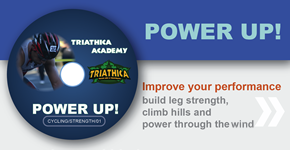 POWER UP!
POWER UP!
Triathica is introducing the first DVD in the Triathica Academy series: Power Up! Power Up! is a 60-minute spin workout designed to help build your leg strength to climb hills and power through the wind.
HOW IMPORTANT ARE RACE WHEELS?
Ron Saetermoe
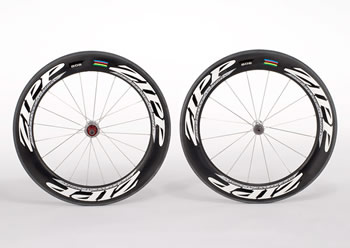
Undoubtedly you’ve seen some really “hot” wheels at your triathlon races. If money is no object you can spend upward of $3,500 for two wheels! Insane, I know, but you’ll see plenty of them at the big races.
First, what are race wheels? Race wheels include solid rear disc wheels as well as deep rim and tri-spoke wheels. There are many different companies that manufacture them and many different varieties.
You’re also aware there are tubular and clincher wheels, aren’t’ you? Tubular tires are thought to be faster overall (but new clincher technology is close behind) but very difficult to change. Essentially tubulars include the tire (the outer part that makes contact with the road) and the tube (the part that holds the air) together as one unit and is glued to the wheel. Clinchers are tires that “clinch” the wheel and have a separate tube inside.
So should you use race wheels? As usual, it depends.
Here are some factors you should consider:
• How competitive are you? If you’re really just racing for fun and are not competitive in your age group it’s not that important. The timesavings, in the right situations, will only save you a fraction of your overall time.
• How important is the race? If it’s not your “A” race (your most important race) you probably don’t need them. Because of the cost, it probably doesn’t make sense to drop all that extra money just to look good.
• What race are you doing? Some races, particularly hilly races, will change your strategy a bit. The added aerodynamics may be offset by the additional weight of a rear disc, for example.
• What length are you racing? You’ll find race wheels at all distances of races from the shortest sprint to full Ironman races. The advantage is relative. Where they may save you 10 seconds on a 12-mile ride they may save you several minutes over the course of an Ironman.
• What about the wind? The primary thing that differentiates race wheels from regular wheels is rim depth. The problem is the greater the rim depth the more difficult it is to manage the bike in a crosswind. For this reason, they do not allow full-disc wheels at the Ironman World Championships because the side-winds are almost always a factor. Lighter riders should also be careful because they will be particularly susceptible to strong winds.
• How’s your head? Many people “think” they’re faster with race wheels, therefore they are. I agree with this, by the way. When my bike is decked out with a set of Zipps, I just “feel” faster.
If you’re concerned about maximizing your aerodynamics but you’re on a budget, it’s probably best to rent race wheels for your “A” races and take the extra dough and enter a couple more “B” races.
TWEAKED
Ron Saetermoe
 Earlier this week a friend of mine and I were moving some stuff . . . some heavy stuff. We moved three large laser printers, two treadmills and some boxes. I don’t know what the printers weighed but the treadmills were 355 pounds each!
Earlier this week a friend of mine and I were moving some stuff . . . some heavy stuff. We moved three large laser printers, two treadmills and some boxes. I don’t know what the printers weighed but the treadmills were 355 pounds each!
We moved all this stuff without incident and then . . . you guessed it . . . . I tweaked my back lifting one of the boxes that probably didn’t weigh but 10 pounds!
Naturally, the thing I thought of first was whether or not I could continue to do my workouts! Funny how we think.
How you deal with injury depends on so many factors. How severe the injury is, your next race, your tolerance for pain, your dedication, your training phase, and even your doctor’s recommendations (I put that one last because most times it seems this is the least important to us).
For me, I subscribe to the “let’s wait and see” philosophy. Rather than call my doc (Dr. Sam Sunshine) and have him order x-rays, MRIs and cortisone injections, I just wait and see. Let’s just see how bad this injury is rather than overreact.
So Tuesday comes around and I’ve got a one-hour CompuTrainer session scheduled. While it’s hard to lift my right leg and get it over my bike, I manage to hoist it over and start spinning. Guess what? It’s a little painful, but tolerable. Okay, this is good.
I’m writing this Friday so it’s been four days since I hurt myself and the pain is still there to be sure. However, since that time I’ve managed to keep working out including a marathon resistance training session yesterday. Very cool!
The real test will come tomorrow though because I plan to ride the 93-mile Palomar loop. Should be nice and hot too! This sufferfest isn’t for the faint of heart but I think my back will hold out.
Now, if my condition gets worse, or if I can’t manage the pain with Aleve alone, I will go see the good doctor, but until then, “rock on!”
Cheers!
SHORT OR LONG?
Ron Saetermoe
 For those of us that work for a living, finding time to train can be one of the biggest challenges you face to reaching your triathlon goals. There simply don’t seem to be enough hours in the day to get everything done.
For those of us that work for a living, finding time to train can be one of the biggest challenges you face to reaching your triathlon goals. There simply don’t seem to be enough hours in the day to get everything done.
The debate still rages on regarding how much training is the right amount. Naturally, you’ll need to train longer if you’re doing 70.3 and Ironman stuff, but how much is enough?
The legend Mark Allen seems to subscribe to the “more is better” school of triathlon training. If you’re training for an Ironman you’d better be prepared to put in 20+ hours of training per week. That’s a part-time job on top of your full-time job!
On the other hand, you’ve got Russ Jones from the “less is best” school of triathlon training. Granted, Russ specializes in shorter triathlon distances but his basic philosophy is shorter sessions but with more intensity.
So who’s right?
Here’s my take on it: they’re both right.
Let me just say that I’m a huge believer in the benefits of cycling with a trainer and running on the treadmill. Can you still become a great triathlete without these tools? Probably, but it will take more time.
Essentially the trainer and treadmill allow you to pack a huge amount of quality training into a tiny chunk of time. Generally my CompuTrainer and treadmill sessions are 60 minutes each. In order to get the same quality of training on the road I might have to do double that, or even more.
And it doesn’t stop there. Your trainer and treadmill sessions should be intense, not easy. You need to rev up the speed, watts and incline to get a real quality session. If you do, you’ll feel quite wasted afterwards but will find that it really helps improve your fitness. When I get off my CompuTrainer at the end of a tough session I can barely stand.
The benefits of the long stuff can’t be overstated either. It’s easier for me to do my long sessions on Saturday and Sunday because I rarely work an entire day during the weekends.
These sessions are more about endurance and pacing than building strength. The other benefit they have is confidence building. If you do a 100-mile bike ride in practice, that 56-mile ride for your 70.3 won’t be as intimidating.
You also benefit by incorporating the long stuff into your workouts by validating your nutrition plan. Less important for sprint distance races but your nutrition plan becomes more important as your races get longer.
So to really maximize the benefits of you limited training time the answer is short AND long.
MIND NUMBING WORKOUTS
Ron Saetermoe
 Are you bored of your workouts? Do you dread doing the same thing day after day? Are you looking for ways to spice your workouts up a bit? If so, you’re not alone.
Are you bored of your workouts? Do you dread doing the same thing day after day? Are you looking for ways to spice your workouts up a bit? If so, you’re not alone.
Some athletes have no problem doing the same workouts over and over again – I think they find it comforting in a way. That’s great: to each his own. But for the rest of us we like to mix it up a bit.
Now, I’m the first to admit that my swim workouts can be quite boring. The only thing that breaks up the monotony is the pain, and the fact that I’m afraid of losing track of what lap I’m on. You see, when I lose track I go back to the lap number I remember – never forward.
So what can you do, and are there any benefits of mixing things up? Currently, I ride on my CompuTrainer five times a week. That’s a lot but I’m really trying to improve my cycling and my run off the bike. So here’s what I do:
Monday: Recovery ride on the CT including very light watts building to 60% of max.
Tuesday: Speed workout on the CT including high cadence (up to 120) and heavy watts building up to 90% of max.
Thursday: Power workout on the CT including low cadence (down to 40) and heavy watts building up to 90% of max.
Saturday: Long road ride (frequently with friends) and short or long transition run afterwards.
Sunday: Easy ride on CT including very light watts building to 60% of max and long run.
This regimen seems to break things up enough for me not to go totally mind numb.
In order to keep the runs interesting I change up the distance, intensity, interval length and rest interval length. Yesterday, for example, I was feeling spontaneous so I left the house without a specific plan other than my total distance.
I normally warm up for about 15 minutes with a slow pace before I do any real intensity. That may seem like a lot but you should remember that I’m 54! After that I decided to do 10 accelerations of 30 seconds with 30 seconds easy running in-between. That takes me up to 25 minutes. I ran easy for an additional five minutes so I was halfway home.
Then I decided to do decreasing intervals with decreasing rest between. I started with a five minute interval with 2:00 slow running, then a four minute interval with 1:30 slow running, three minutes/1:00, two minutes/0:30.
So that was my workout yesterday. No particular reason, just felt like it. It was great and I didn’t feel the least bit bored by it.
Cheers!
RACE REPORT, SPRINT NATIONAL CHAMPIONSHIPS
Julia Juliusson
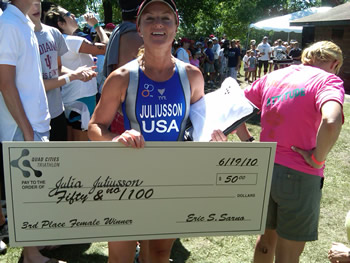 So here’s the Race report from the National Sprint Qualifier for Worlds in Iowa!
So here’s the Race report from the National Sprint Qualifier for Worlds in Iowa!
2010 Quad Cities Sprint Tri on June 18th was the national qualifying race for anyone wanting to be on Team USA for ITU Sprint World Championships in Budapest September 12th.
This is a changeover year in that USAT made the race in Tuscaloosa, AL September 19th the National Sprint Championship for 2010 but that occurs AFTER Worlds so it cannot be a qualifier. So even though I won my age group at the qualifying race for Worlds, I can’t say I am the National Sprint Champion because that race has yet to occur!
Still, the Quad Cities Triathlon attracted triathletes from 35 states, with MANY returning World’s athletes trying to qualify again. It was held in the middle of nowhere Iowa . . . quite an experience in itself.
I flew in on Thursday before the race (on Saturday) and quickly realized . . . “I’m not in Kansas anymore.” While the people were very friendly in the Milwaukee airport, I felt like I was in the movie Fargo. People just sounded funny and truly were mid-west!
I flew there to meet my friend Heidi who is from Wisconsin and also competed in
Sprint Worlds last year. Together we drove three hours to Davenport Iowa to stay for the race.
On Friday we woke up early and met fellow So Cal teammates Russ Jones, Sam Sunshine, Renee Rodarte, and Mark Disman to pre-ride the course. It was cloudy and windy. We rode the 15-mile course of rolling hills with a few short climbs just before the weather took a turn for the worse.
We went to breakfast and watched as a severe storm cell overtook the town with Wizard of Oz type rain wind and tornados super severe rain!! We sat and stared outside saying “OMG what if it does this tomorrow!”
Fortunately, it didn’t. We lucked out and the clouds parted for race day Saturday. It was a warm sunny day with moderate wind on the course, which literally took us through the cornfields of Iowa. The lake was 74 deg (toasty in the long sleeve wetsuit I had) the air was about 85 and fairly high humidity. The swim had a time trial start with two people going off every three seconds. I had never done that kind of start before. It was okay. It still did not make it any easier to get to clear water I still had to swim through a sea of slower swimmers as they always start women 40 and over next to last!!
I had a great swim though — 600 yds in 9:59. Happy with that one. Then a great bike: 15 miles in 40 minutes. Then a good 5K. (trails, grass and hills).
My friend Heidi pushed me on the bike and swim. She mountain bikes a TON and she is very strong on the bike because of it. She is also a natural runner and always goes a little faster than me. I swam faster than her but she runs faster so we always come in about the same time.
I finished the race without anyone passing me so I figured I had done well. I go to get my results and find out I am not in my age group listing at all! I have a panic attack and begin to think I have been DQ’d for some reason. I knew that I hit or maybe crossed over the center yellow line at one point trying to pass people so maybe I got DQ’d for that?
I ran to a USAT official. No my name is not on any penalty or DQ list!
Finally I go to the timing company . . . “Where am I?”
They have pulled me out for the overall. I am 3rd Overall ( female)!! They say I can’t “double dip” and win my AG and win an OA award. They were giving cash prizes for OA!!
I tell them I don’t want the cash prize I want to qualify for Worlds, and I am amateur so I can’t accept money!!
NO, NO I am thinking I want Door #2 not Door #1 . . . put me back in age group I say. I want to win my AG!
No they say, I have won 3rd overall and I’m getting a check! So I run back to the USAT official and plead . . . “Can I still qualify for Worlds if I accept the check??” YES is the answer. Turns out all three OA females were all age groupers and we beat the Elites that day!!
We all declared ourselves so we all qualified for Worlds!! Whooo Hoooo! We are going to Budapest 2010 ITU Sprint World Championships!
I intend to podium! Going for the Gold!
Nice people in the mid-west. Remind me to race there more often!!
Julia Juliusson ( 45-49 Female)
TRIATHICA ACADEMY UPDATE
Ron Saetermoe
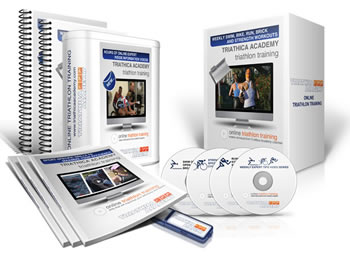
We’ve talked several times about our new mission here at Triathica . . . the Triathica Academy. Well, that mission is about to be deployed and we hope you’ll come along.
The Triathica Academy is a “paid for” subscription service aimed at helping develop triathletes of all levels. It is (will be) the most comprehensive online triathlon development website in the world including workouts, training plans and information to help improve your health, fitness and triathlon performance.
To give you a flavor for where the Triathica Academy is headed I hope you’ll join us on YouTube at the Triathica Academy Channel here: http://www.youtube.com/user/TriathicaAcademy
We’ve posted three free videos from our “Triathlon Experts” series:
Episode 1: Women in Triathlon with Sherry Rennard. Sherry shares her insights about women in triathlon and has some advice for women who want to get into the sport of triathlon.
Episode 2: Finding a Good Massage Therapist, Kathy Flippin: Kathy talks about what to look for when choosing a massage therapist. She tells us why seeing a massage therapist who specializes in sports massage is important.
Episode 3: Weight Loss with Kristy Richardson: Kristy talks about weight loss for the triathlete and how to attain the proper weight through good nutrition.
And this is only the beginning. We’ll have lots more videos, podcasts and workouts at the Triathica Academy.
Watch for more details.
Cheers!
BREAKTHROUGH TRAINING
Ron Saetermoe
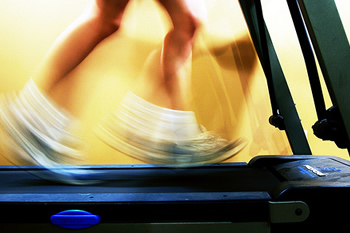 When was the last time you had a breakthrough training day? Have you ever had a breakthrough training day? What is a breakthrough training day?
When was the last time you had a breakthrough training day? Have you ever had a breakthrough training day? What is a breakthrough training day?
Let me give you my perspective on the subject and why it’s important.
My definition of a breakthrough training day is one that you push beyond your previous limits and perform harder and/or than you ever have previously. When I have these kinds of days I surprise myself because I thought that my previous efforts were the best I could do.
As I’ve written before, one of my training secrets is the CompuTrainer (a trainer for your bike that measures watts, or effort). My pal Lar Dog Davidson turned me on to this tool and I used it extensively when I was working with another coach. The great thing about the CompuTrainer is that the numbers simply don’t lie.
Consider going to the gym and working out with weights but having no idea how much weight you’re lifting. Unfortunately, many people train on the bike that way. You may be working hard but without some form of measurement (besides speed or cadence, or even heartrate) you really don’t know how much work you’re actually doing.
So the benefit the CompuTrainer has is you know exactly how many watts you’re pushing. In my case I have a favorite power workout I do. Essentially I keep increasing the watts while decreasing the interval. For example, I’ll push 200 watts for five minutes, then rest two minutes. The next interval will be 210 watts for four and a half minutes, etc.
My breakthrough workout then is when I start my first interval at 210 watts instead of 200. That extra 10 watts doesn’t sound like much but consider that 10 watts is a 5% improvement. Consider that a 5% improvement on the bike is like the difference between going between 20 and 21 miles per hour. Take a look at the bike splits sometime of the top people in your age group. Chances are there’s less than a 5% difference in time.
Sometimes before and during these workouts I have no idea if I can finish. Guess what, sometimes I don’t. There are a lot of factors involved including your glycogen stores, your rest the night before and previous workouts and recovery. Breakthrough workouts don’t happen everyday . . . that’s why they’re called “breakthrough.”
Perhaps the best breakthrough workout I had this year had to do with my bricks. Like just about everyone, I struggled after a hard bike workout to run. But if you can’t run well off the bike you’re not going to do well in this sport.
One morning in February at 4:30 in the morning I got on my CompuTrainer for a hard 60-minute workout and a transition run. When I got off my bike my legs were pretty wobbly so I thought I’d limit my run to my short course (about two miles). But when I started to run I felt great, even after pushing so hard on the bike. I was surprised that my stride was so fluid and strong so I decided to do my long T-run of six miles, and I felt great!
That was a breakthrough for me. Since that day I’ve been able to duplicate my performance at least once a week.
Don’t just workout. If you really want to get better you really need to push yourself hard occasionally. Trust me, you’ll surprise even yourself.
STAYING MOTIVATED
Ron Saetermoe
 It’s not always easy to stay motivated. For me, it’s easy to stay motivated as an important race is approaching (mostly because of the fear I suppose) but in the beginning or middle of my year it certainly isn’t.
It’s not always easy to stay motivated. For me, it’s easy to stay motivated as an important race is approaching (mostly because of the fear I suppose) but in the beginning or middle of my year it certainly isn’t.
I actually think you can develop motivation as a habit (or addiction). I’m one of those people that never has to set an alarm to get up in the morning, no matter what time I get to bed. Without fail I’m up at 5:00 every morning. Sometimes a half hour earlier or later but almost always at 5:00.
So here’s what I find: I go through stages prior to my workout.
Stage 1: Get moving. So when I’m awake and I’m not feeling particularly motivated I can either lie there or attempt to go back to sleep (which is rare) or just start moving. I’ll use the restroom, get a drink, get dressed and try to get my mind into the workout I have planned (yes, all of my workouts are planned well in advance).
Stage 2: Dial back. At this point I’ll frequently convince myself that I’ll dial back my workout. This helps me get started. Hey, a 30-minute easy spin sounds better than a 60-minute sufferfest! Dave Scott always said any workout is better than no workout.
Stage 3: Get started. So I’ll start out on my swim/bike/run workout satisfied that I’m going to work less than my plan. Then, something funny happens – the workout doesn’t seem so bad so I enter the next mental stage of my workout.
Stage 4: Bring it! Generally, once I get started I feel better than I thought I would. That’s not always the case but usually is so I muscle through the first couple intervals. It feels hard, but definitely doable.
Stage 5: I did it! After I’ve finished one of my planned workouts when it looked like I might totally sloth, I’m very proud of myself. Sure it’s exactly what I had planned but I could have just as easily skipped it. Damn I’m good!
This is how it works for me on those days I’m just not feeling motivated. What do you do?
Cheers!


